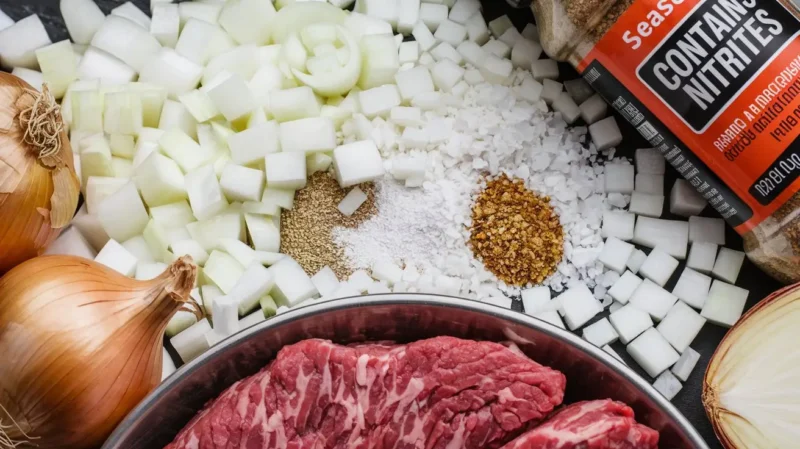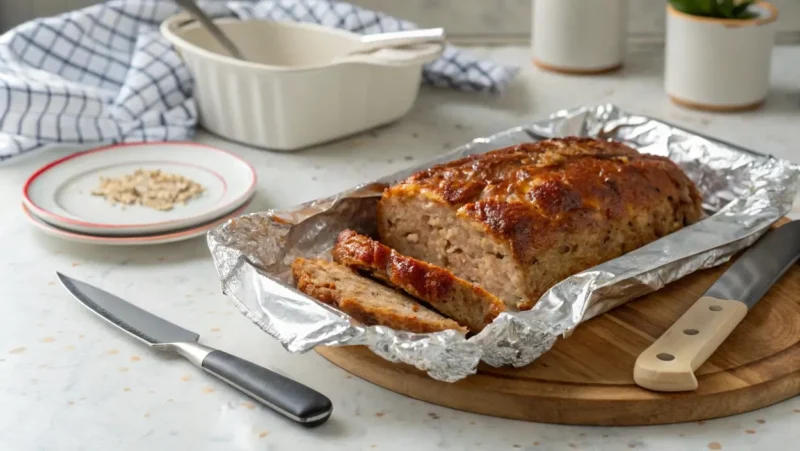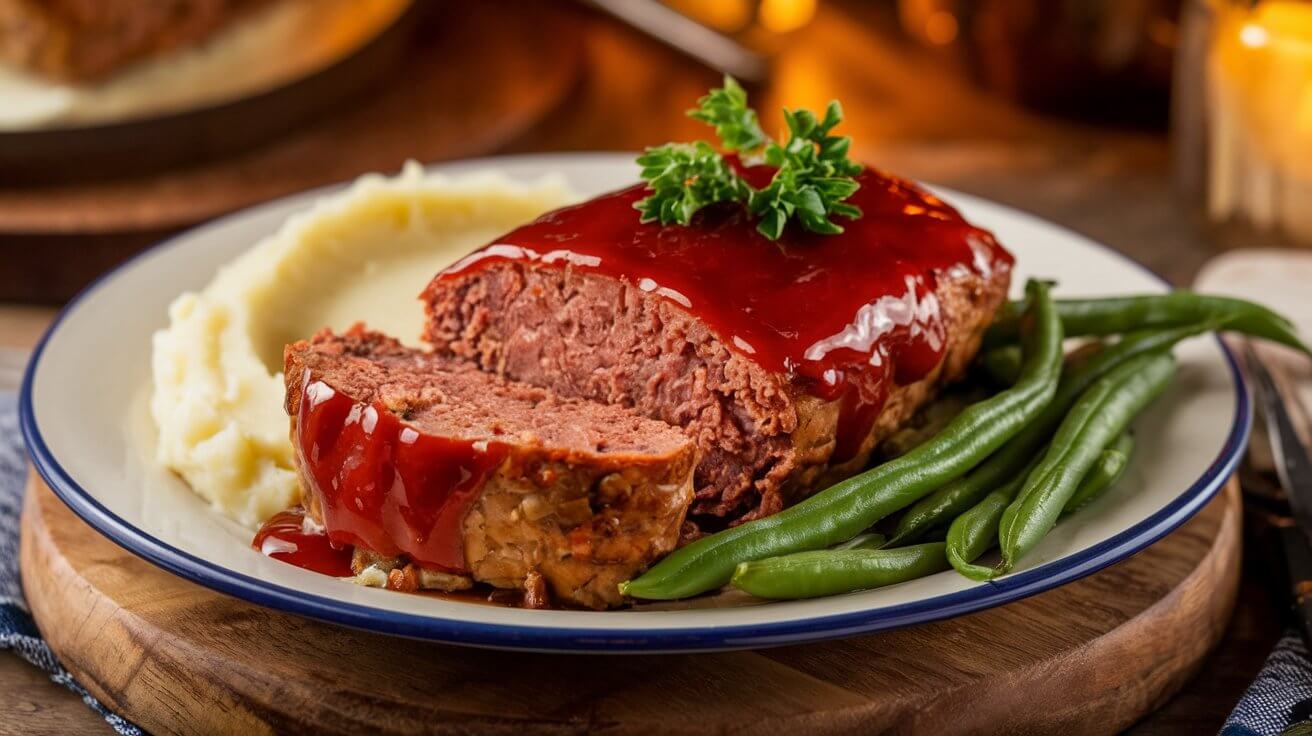Eggs are one of the unsung heroes in meatloaf recipes. Acting as the glue that holds everything together, they’re essential for binding the ingredients into a cohesive loaf. But as vital as they are, there’s such a thing as overdoing it. Too many eggs in Meatloaf can drastically change the texture, flavor, and structure of your meatloaf, turning it into a culinary experiment gone wrong. Let’s unpack why eggs are important and what happens when you add too many.
Table of Contents
The Purpose of Eggs in Meatloaf
Eggs play several key roles in meatloaf preparation:
- Binding: Eggs ensure the mixture holds together during cooking and slicing.
- Moisture: They contribute liquid to prevent dryness.
- Texture: The proteins in eggs firm up as they cook, giving the meatloaf a pleasant structure.
- Flavor: While subtle, the richness of eggs enhances the overall taste.
Think of eggs as the framework of your meatloaf. Without them, the mixture might crumble. But too many eggs can backfire, shifting the balance and resulting in unexpected consequences. For a deeper dive into achieving perfect flavor balance, check out our guide on meatloaf seasoning.
What Happens When You Add Too Many Eggs in Meatloaf?

When you overuse eggs, your meatloaf’s characteristics change noticeably:
- Soft, Rubbery Texture: Excess protein from the eggs creates a dense or sponge-like texture.
- Loss of Structure: Instead of holding its loaf shape, the meatloaf may collapse or become too mushy.
- Overpowering Eggy Flavor: Too many eggs dominate the taste, overshadowing the spices and meat.
These issues can leave you with a dish that’s less appetizing and far from the comfort food classic you were expecting. To explore more innovative twists, consider trying our smoked meatloaf recipe for a flavorful variation.
Spotting the Signs of Too Many Eggs
If your meatloaf isn’t turning out right, these signs might confirm an egg imbalance:
- Pudding-Like Consistency: The texture feels more like a custard than meatloaf.
- Excessive Moisture in the Pan: Eggs release water as they cook, leaving the pan swimming.
- Unpleasant Eggy Smell: A strong egg aroma is another clue.
Recognizing these symptoms early can help you adjust before baking.
The Ideal Egg-to-Meat Ratio
Most recipes recommend 1 to 2 eggs per pound of meat, which strikes a balance between structure and moisture. Adjustments can be made if you’re adding extra ingredients, like vegetables or fillers, but it’s always better to err on the side of caution. Start with fewer eggs, you can always add more if needed. For tips on getting the perfect bake, check out how to cook a 1 lb meatloaf.
Quick Fixes for Too Many Eggs
If you’ve already gone overboard, here’s how to save your mixture:
- Add Ground Meat: Adding more meat to the mixture balances out the extra eggs.
- Incorporate Dry Ingredients: Use breadcrumbs, crushed crackers, or oats to absorb the excess moisture.
- Refrigerate Before Baking: Let the mixture chill for 30 minutes to firm up.
With these simple fixes, your meatloaf can still be a hit at dinner.
Avoiding Common Mistakes with Eggs in Meatloaf

While eggs are crucial to a successful meatloaf, it’s easy to make mistakes that throw off the dish’s texture or flavor. Whether you’re adding too many eggs or forgetting to measure, a small error can have a big impact. For more on troubleshooting, explore our guide on why your meatloaf might still be pink.
Common Mistakes When Adding Eggs
- Overloading with Eggs: More isn’t always better. Adding extra eggs thinking it will make the loaf firmer often results in a rubbery texture.
- Eyeballing Measurements: Guessing egg quantities instead of following a recipe can lead to imbalanced ratios.
- Skipping Fillers: Eggs can’t do all the work. Without breadcrumbs, oats, or crackers, your meatloaf may lack the support it needs.
- Not Considering Egg Size: Egg sizes matter! A recipe calling for “2 eggs” assumes large ones, using jumbo eggs might be too much.
Avoiding these pitfalls ensures a balanced mixture and a meatloaf that slices perfectly every time.
How to Fix Too Many Eggs
So, you’ve realized there’s too much egg in your meatloaf mixture, don’t panic! Here are some ways to fix it:
- Add More Meat: The easiest way to rebalance is by incorporating additional ground meat, such as beef, pork, or turkey.
- Increase Binders: Mix in more breadcrumbs or crushed crackers to soak up the extra liquid.
- Test the Texture: Form a small patty from the mixture and cook it in a skillet. Adjust as needed before baking the entire loaf.
- Use a Loaf Pan: A structured pan can help support a mixture that’s slightly wetter than usual.
“Cooking is about problem-solving, too many eggs is just another opportunity to get creative in the kitchen.”
Balancing Ingredients for the Perfect Meatloaf
A successful meatloaf comes down to the right ratios. Eggs are important, but they’re just one component in a blend of meat, binders, and seasonings. Here’s how to strike the right balance:
- The Meat: Use a mixture of ground beef and pork for a balance of flavor and fat. Turkey or chicken can be substituted but may require extra moisture.
- The Binders: Breadcrumbs, oats, or crushed crackers are essential for holding everything together. Add just enough to soak up moisture without making the loaf dry.
- The Fillers: Grated vegetables like onions, carrots, or zucchini add moisture and flavor while complementing the eggs.
- The Seasonings: Bold flavors like garlic, parsley, Worcestershire sauce, and paprika can elevate a basic recipe into something unforgettable.
Each ingredient plays a unique role. When balanced properly, they create a cohesive, flavorful meatloaf.
Tips for Measuring Ingredients Accurately
Precision is key when making meatloaf. To avoid overloading with eggs, follow these tips:
- Crack Eggs Separately: Always crack eggs into a separate bowl before adding them to the mixture. This allows you to measure and avoid accidental shell fragments.
- Weigh the Meat: Recipes often assume specific weights for meat. Using a kitchen scale ensures accuracy.
- Mix Gently: Overmixing can lead to a dense loaf, even with the right ratios. Combine ingredients until just incorporated.
These small adjustments can make a big difference in the final dish.
Substituting Eggs in Meatloaf

Whether you’re out of eggs or catering to dietary restrictions, substitutes can work wonders. Here are some popular egg alternatives:
- Breadcrumbs and Milk: A classic combination that binds and adds moisture.
- Flaxseed Meal: Mix 1 tablespoon of flaxseed with 3 tablespoons of water for a plant-based substitute.
- Mashed Potatoes or Sweet Potatoes: These starchy options hold the mixture together while adding a unique flavor.
- Greek Yogurt: A spoonful of yogurt can replicate the richness of eggs while keeping the mixture moist.
Pro Tip: When using substitutes, start with small amounts and adjust based on the texture of the mixture.
Signs of a Balanced Meatloaf
How can you tell if your meatloaf mixture is perfectly balanced? Look for these signs:
- Moist, But Not Wet: The mixture should hold its shape when molded into a loaf.
- Even Texture: Ingredients should be evenly distributed, with no large pockets of breadcrumbs or vegetables.
- Flavors in Harmony: No single ingredient should overpower the others, especially the eggs.
“A balanced meatloaf is like a well-tuned orchestra, every ingredient plays its part to create a harmonious dish.”
Advanced Meatloaf Tips for Eggs and Beyond
Now that you’ve mastered the basics of egg usage in meatloaf, it’s time to explore advanced strategies. These tips will elevate your meatloaf from a weeknight staple to a show-stopping dish. Plus, we’ll address some common questions to ensure you have all the answers at your fingertips.
Creative Twists for Perfect Meatloaf
Looking to shake things up? Try these creative ideas:
- Cheese-Stuffed Meatloaf: Layer mozzarella or cheddar in the center of your meatloaf mixture for a gooey surprise.
- BBQ Glaze: Swap traditional ketchup for a tangy barbecue sauce to create a smoky crust.
- Spicy Kick: Add chopped jalapeños, cayenne pepper, or hot sauce for a bold flavor twist.
- Vegetarian Alternative: Use lentils, beans, or a mix of hearty vegetables for a delicious egg-free and meat-free version.
Experimenting with these variations can make your meatloaf stand out while keeping the balance of ingredients intact.
How Resting Time Enhances Meatloaf
Once your meatloaf comes out of the oven, resist the urge to cut into it right away! Letting it rest for 10–15 minutes allows the juices to redistribute. This ensures every slice is moist and flavorful, with no messy crumbles.
Pro Tip: Cover the loaf loosely with foil while resting to keep it warm without trapping steam, which could make the crust soggy.
Common Questions About Eggs in Meatloaf
How many eggs are ideal for meatloaf?
The standard ratio is 1 to 2 eggs per pound of meat. Adjust based on the recipe or additional fillers.
Can I make meatloaf without eggs?
Yes! Alternatives like breadcrumbs with milk, flaxseed with water, or mashed potatoes work well.
What happens if I skip the binder entirely?
Without a binder, your meatloaf is likely to crumble. Eggs, breadcrumbs, or substitutes are essential to holding it together.
How do I avoid overcooking?
Use a meat thermometer to ensure the internal temperature reaches 160°F. Remove the loaf promptly and let it rest.
Why does my meatloaf taste eggy?
Too many eggs in the mix can overpower the flavor. Stick to the recommended ratio to avoid this issue.
Avoiding Other Common Pitfalls
Even if you’ve nailed the egg ratio, other factors can still trip you up. Here’s how to avoid common meatloaf problems:
- Dry Loaf: Ensure there’s enough fat in your meat and moisture from ingredients like milk or vegetables.
- Soggy Loaf: Don’t overload with liquid ingredients, and avoid skipping fillers like breadcrumbs.
- Falling Apart: Always use a binder, and don’t skip resting time after cooking.
“Mastering meatloaf is all about finding the right balance, not just with eggs but with every ingredient on your list.”
Final Thoughts on Eggs in Meatloaf
Eggs are the cornerstone of any great meatloaf, but their role is all about balance. Too few, and your loaf might fall apart; too many, and it risks turning rubbery or overly moist. By understanding the science behind eggs as a binder, using the right ratios, and incorporating creative solutions when things go wrong, you can perfect your recipe every time.
Whether you’re making a classic meatloaf or experimenting with bold new flavors, remember: cooking is as much about technique as it is about taste. With these tips in hand, your meatloaf is sure to be a hit.
“The secret to a great meatloaf is like life itself, balance everything, and the results will always be satisfying.”

